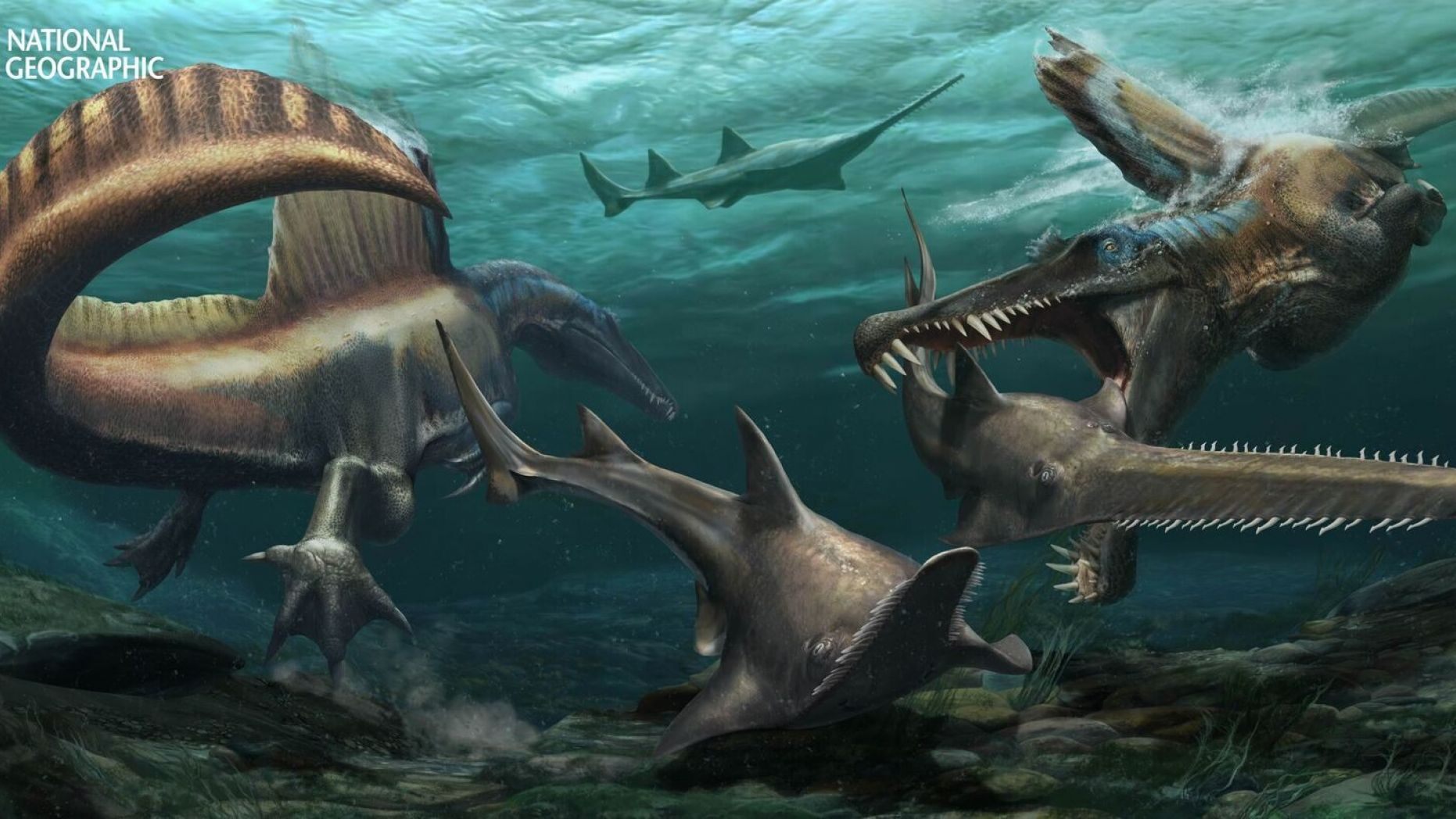Terrifying Spinosaurus had powerful tail, becoming first known aquatic dinosaur

Researchers have discovered that Spinosaurus aegyptiacus, the terrifying aquatic dinosaur that lived 100 million years ago, had a powerful tail that enabled it to be accustomed to an aquatic lifestyle, the first time such an adaptation has been reported in a dinosaur.
According to the study, Spinosaurus had a “tail with an unexpected and unique shape” made up of “extremely tall neural spines and elongate chevrons, which forms a large, flexible fin-like organ capable of extensive lateral excursion.”
“The Spinosaurus’ fin-like tail is a game-changing discovery for us that fundamentally alters our understanding of how this dinosaur lived and hunted — it was actually a ‘river-monster,'” one of the study’s co-authors, David Unwin, said in a statement.
Two SpinosaurushuntOnchopristis, a prehistoric sawfish, in the waters of the Kem Kem river system in what is now Morocco. (JasonTreat, NG Staff, and Mesa Schumacher Art: Davide Bonadonna)
Two SpinosaurushuntOnchopristis, a prehistoric sawfish, in the waters of the Kem Kem river system in what is now Morocco. (JasonTreat, NG Staff, and Mesa Schumacher Art: Davide Bonadonna)
THE MOST DANGEROUS PLACE IN THE HISTORY OF PLANET EARTH REVEALED
“Not only did dinosaurs dominate the land and take to the air as birds, they even went back into the water and became the top predators there, as well,” Unwin added.
A skeleton of the Spinosaurus, which was featured in “Jurassic Park III,” was discovered in the Kem Kem River beds. This area in the present-day Sahara was recently described as “arguably the most dangerous place in the history of planet Earth.”
Team members unearthing a large Spinosaurus bone. (Paolo Verzone/National Geographic)
Team members unearthing a large Spinosaurus bone. (Paolo Verzone/National Geographic)
Along with Spinosaurus, fossils from the three largest predatory dinosaurs have been discovered at Kem Kem, which was comprised of a vast river system 100 million years ago. These include the saber-toothed Carcharodontosaurus, which was over 26 feet long, and the raptor Deltadromeus, which was around 26 feet in length.
“This dinosaur was actively pursuing prey in open water, not just standing in the shallows waiting for fish to swim by,” the study’s lead author, Dr. Nizar Ibrahim said in the statement.
THE DAY THE DINOSAURS DIED: ASTEROID IMPACT SITE REVEALS DEVASTATION FROM POWER OF 10 BILLION A-BOMBS
Despite the fact that mosasaurs and plesiosaurs terrorized the ancient oceans of the planet, they are not considered dinosaurs.



 Creators of mankind
Creators of mankind Description of “Tall white aliens”
Description of “Tall white aliens” Where they came from?
Where they came from? About hostile civilizations
About hostile civilizations The war for the Earth
The war for the Earth “Tall white aliens” about eternal life
“Tall white aliens” about eternal life Video: “Nordic aliens”
Video: “Nordic aliens” Aliens
Aliens Alien encounters
Alien encounters The aliens base
The aliens base UFO
UFO Technology UFO
Technology UFO Underground civilization
Underground civilization Ancient alien artifacts
Ancient alien artifacts Military and UFO
Military and UFO Mysteries and hypotheses
Mysteries and hypotheses Scientific facts
Scientific facts


















